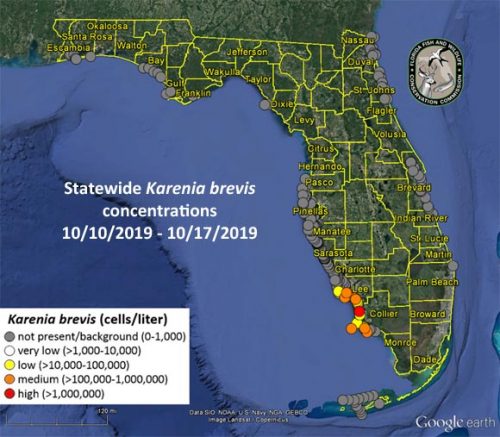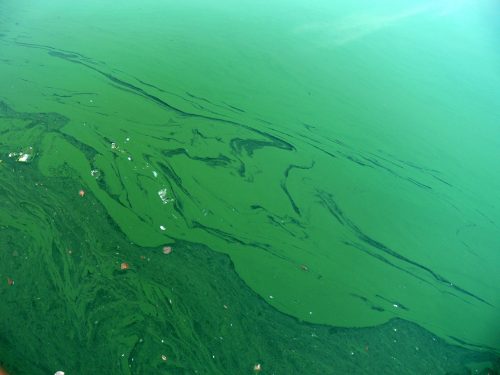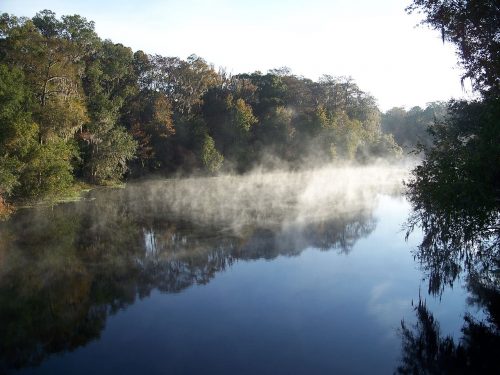Gov. Ron DeSantis announced proposed legislation based on recommendations from the state’s Blue-Green Algae Task Force as red tide returns to Southwest Florida.
Meanwhile, worrying trends arise in the St. John’s “State of the River” report and Alachua County advocates try to establish a bill of rights for the Santa Fe River as part of a growing legal trend.
Red Tide Returns

What’s going on?
Red tide has made an unwelcome comeback in Sarasota, Lee and Collier counties. Fish kills have been reported in Lee and Collier counties.
Why it matters.
Red tide is considered a harmful algal bloom due to its impacts on the environment, humans and coastal economies.
How do we contribute to the problem?
While red tide predates human influence, it is likely that humans plays a role. This is because blooms feed on excess nitrogen and phosphorus once they make their way to our coasts. These excess nutrients come from a variety of sources such as stormwater runoff, fertilizer runoff, septic tanks and/or faulty wastewater systems. Scientists say these excess nutrients play a role in the extent and duration of large blooms.
What can I do?
- Report fish kills to the FWC Fish Kill Hotline at 800-636-0511 or submit a report online.
- Report distressed wildlife (e.g. marine mammals and sea turtles) to FWC at 1-888-404-FWCC
- Volunteer with the FWC’s HAB program to collect water samples in under-represented areas.
Where can I learn more?
- Read more on this Red Tide information page.
- Watch our public panel, Beyond Dead Fish: How Red Ride Affects All Floridians
- Stay up-to-date with FWC’s Red Tide Current Status page
Blue-Green Algae Task Force Makes Recommendations

What’s going on?
The state’s Blue–Green Algae Task Force made recommendations to increase inspections on the state’s 2.5 million septic tanks and set limits on where they can be installed. The task force also wants to update aging sewer systems and revise design criteria for stormwater drainage systems so that they can better clean runoff. On Oct. 16, Gov. DeSantis announced proposed legislation based on the group’s recommendations.
Meanwhile, the Centers for Disease Control and Prevention is considering launching a new study to measure the health effects of high exposure to toxic algae on Lake Okeechobee.
Why it matters.
Intense blue-green algae blooms like the ones we experienced in 2016 and 2018 reflect decades of adding fertilizer, growing crops, raising cows and cattle, fertilizing lawns and installing septic tanks – around once-pristine water bodies. Gov. DeSantis established the Blue-Green Algae Task Force this year to focus on expediting water quality improvements.
What’s next?
The task force is working to finalize proposals in advance of Florida Legislative session.
What can I do?
- Familiarize yourself with the Blue-Green Algae Task Force latest recommendations to the state.
Where can I learn more?
- Visit this Blue-Green Algae bloom information page.
- View the latest satellite imagery of algae blooms, in Lake Okeechobee and elsewhere by visiting the NOAA National Centers for Coastal Ocean Science Harmful Algal Bloom Monitoring System.
River Rights

What’s going on?
Alachua County advocates are leading an initiative to grant legal rights to the Santa Fe River, its springs and the aquifer. The petition states the river “possesses rights including, but not limited to, the right to naturally exist, flourish, regenerate and evolve.”
So far, the group has received about 16% of the signatures it needs to get the measure on the general election ballot next year.
Why it matters.
The group says the initiative would give Alachua county residents more power to challenge projects that degrade the river, like a recent permit renewal from Nestle to pump roughly 1.2 million gallons of water a day from Ginnie Springs. But oppponents say the legislation would be costly and could lead to government overreach.
A similar bill was passed in Lake Eerie, but was challenged within days by a farmer stating the bill was unconstitutional.
Initiatives to give ecosystems legal rights are growing in popularity. According to the American Association of Geographers, this type of legislation is driven by “the clear signals worldwide of increasing ecological degradation at systemic levels, ranging from climate change to greatly accelerated species loss across ecosystems.”
If the amendment is approved, the county will have to make guidelines as to what constitutes a violation.
What’s next?
For the measure to be on the ballot, the group must collect approximately 18,000 signatures by Feb. 22.
What can I do?
Where can I learn more?
- Read the story in The Gainesville Sun.
- Learn more about the “Rights of Nature.”
Water woes
What’s going on?
A new report found several worrying trends in the St. Johns River. Sea level rise and dredging are leading to saltier water, which can result in the redistribution of fish and loss of submerged aquatic vegetation. The report’s authors also point out nutrient pollution, loss of wetlands and increases in non-native species as areas of major concern.
Why it matters.
The St. Johns River is Florida’s longest river and is vital to the people, animals and plants that live in northeast Florida. The river supports the economy through the Port of Jacksonville and the thousands of businesses, schools, and other agencies that have located there. It also provides vital ecosystem services. For example, a 2011 study shows the river’s wetlands provide billions of dollars worth of yearly nitrogen and phosphorus removal, two nutrients that in excess can lead to eutrophication, or oxygen depletion, as well as algae blooms.
What can I do?
- Learn more about the individual actions you can take to improve the river’s health.
- Familiarize yourself with the River Health Indicators.
Where can I learn more?
- Read the 12th State of the River Report
The Takeaway Message
Algae blooms are on the minds of state lawmakers as they prep for the upcoming the legislative session. Worrisome trends are brought to light in the St. Johns River at the same time Sante Fe River advocates are working to establish a bill of rights for the river and the ecosystems it supports.
It is clear that water quality and quantity are always pressing issues for Florida’s waterways.